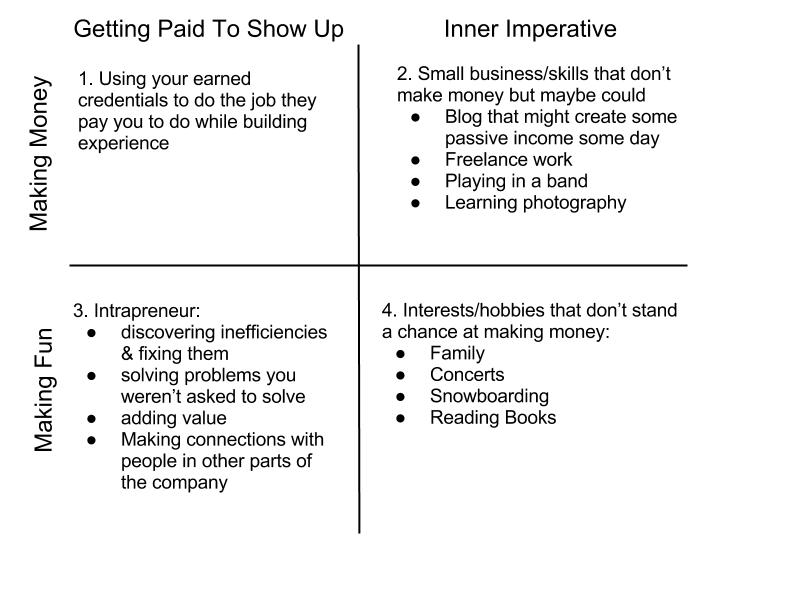
This is my latest strategy for having a balanced and fulfilling life. I think it requires living in all four of the quadrants above. It comes down to how often, why, for whom and how much you create. I believe creation is a fundamental human need. The more you create the happier you are. What is not listed above are those things that are neither inner imperatives nor do they make you money. These are the things that should be avoided – channel surfing, Facebook, relentless entertainment. Some entertainment is inspiring but most isn’t. Unfortunately most people devote a large portion of their lives to being entertained instead of creating.
I espouse to Hugh McLeod’s Sex and Cash Theory where he explains that a person can balance the need to make a good living while still maintaining one’s credibility. You do this by having a day job that allows you to pursue other interests when you’re not at work. Diving head first into a your own start up is not necessary to feeling fulfilled, and might make you less so.
I think maintaining a day job is a great idea. You may not be having the time of your life, but I think that’s okay for four reasons.
First, everyday at work builds your employability equity. Experience is an asset you’ll never regret having.
Second, if you’re living in all four quadrants, your life won’t be solely based on your job.  I think it’s short sighted to assume your life’s purpose can be found solely from a company whose purpose is to make a profit. No matter how great your full time job is, it has proven time and again that financial incentives have a negative effect of performance and fulfillment. In the book Drive by Dan Pink, he says that punishment and reward based systems destroy creativity and that the secret to high performance isn’t rewards and punishments, but intrinsic drive. The drive to do things for their own sake. A place that pays you to be there will always take away that intrinsic drive, so don’t rely on it so much for your well being.
Third, keep in mind what Cal Newport explains in his great book, So Good They Can’t Ignore You – that passion in a career is more likely to happen after you become expert.
Fourth, even though our culture might make you feel otherwise, I think it’s okay to take an undemanding job to afford you more time to pursue other interests and activities in the quadrants three and four.
Hopefully time spent at work can also be devoted to being an intrapreneur – quadrant 3. Doing the things in quadrant 3 will build more employability equity and makes the 40 hours a week more fun and engaging. I think the leading cause of job dissatisfaction is when people devote their whole life to quadrant 1 but can’t get traction with quadrant 3 initiatives. As strange as it sounds, many people want to give more than the company they work for will allow. So instead of feeling burnt out, invest that energy into inner imperatives.
Inner imperatives provide the fuel for everything else. Bill Watterson, creator of Calvin & Hobbes, said in a commencement speech, “We need to do more than find diversions; we need to restore and expand ourselves. Our idea of relaxing is all too often to plop down in front of the television set and let its pandering idiocy liquefy our brains. Shutting off the thought process is not rejuvenating; the mind is like a car battery-it recharges by running.†Social media, nightly news and reality shows all take more than they give. To be fulfilled you need to learn how to relax through creating via quadrants 2 and 4. Ken Robinson, in his book The Element, explains that the most rejuvenated, inspired and excited states of being happen when we are experiencing Flow, or The Zone. It’s the magical place where your intrinsic talent is paired with the explosive power of passion – a much better place to be than rotting in front of the TV.
What I like about this framework is that when you live in all four quadrants you create what Steven Johnson, in his book Where Good Ideas Come From, calles the “personal intellectual environment”. This is where you have lots of different ideas, different backgrounds, different interests, jostling and bouncing off each other to create an environment that leads to innovation. Each quadrant supplies skills, ideas, insight, opportunity and motivation to the other quadrants. You’re balanced and motivated.